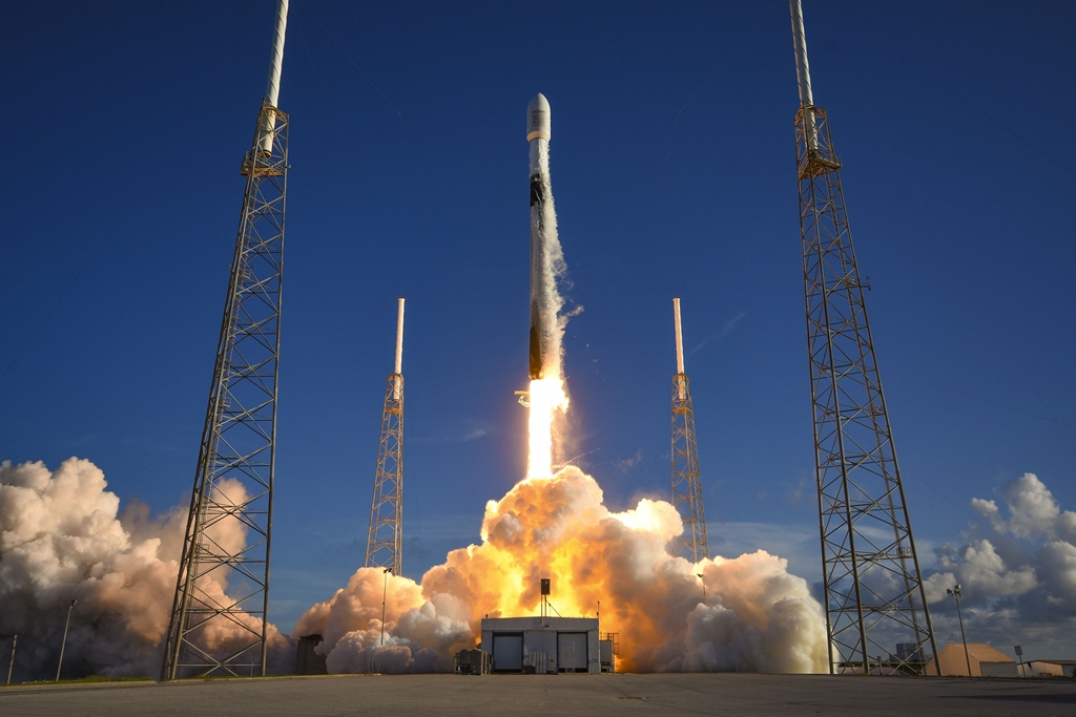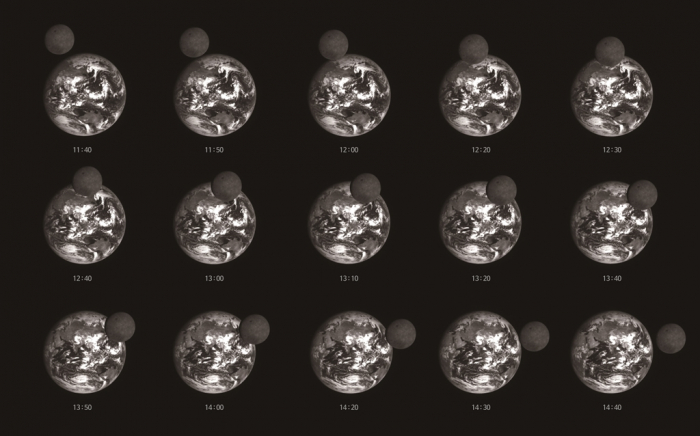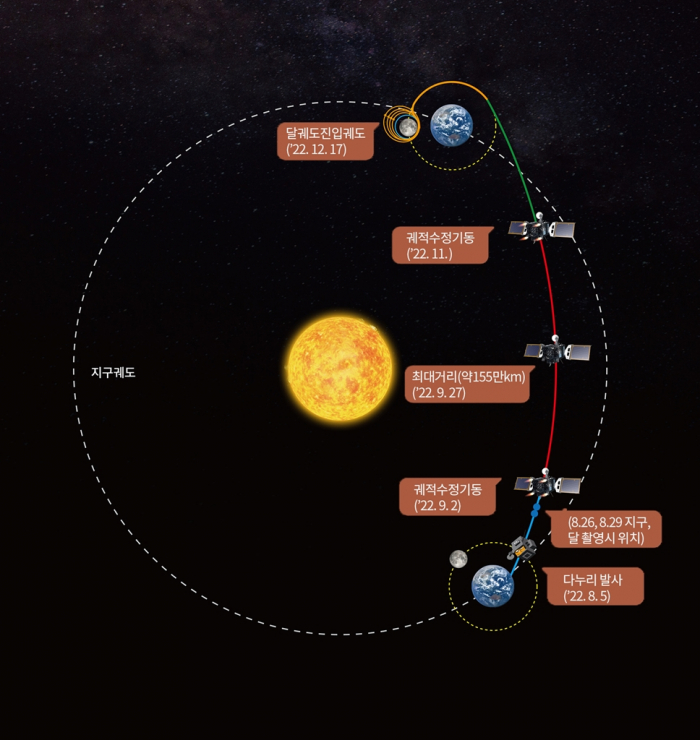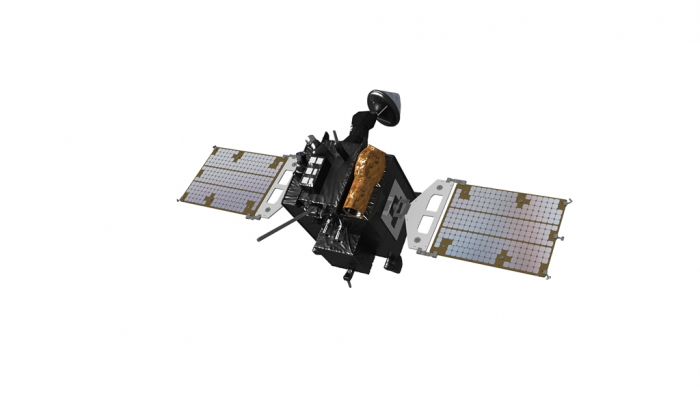Aerospace & Defense
Korea’s 1st moon probe Danuri enters lunar orbit; world’s 7th mission
With even bolder lunar and planetary ambitions, Korea aims to launch a moon landing and a Mars orbiter by 2035
By Dec 28, 2022 (Gmt+09:00)
3
Min read
Most Read
LG Chem to sell water filter business to Glenwood PE for $692 million


Kyobo Life poised to buy Japan’s SBI Group-owned savings bank


KT&G eyes overseas M&A after rejecting activist fund's offer


StockX in merger talks with Naver’s online reseller Kream


Mirae Asset to be named Korea Post’s core real estate fund operator



South Korea on Wednesday became the world’s seventh country to send a lunar orbiter to the moon, joining other advanced countries in a heated race for deep-space exploration missions.
Danuri, Korea’s first lunar orbiter, successfully entered the target orbit of the moon earlier than planned, after a nearly five-month voyage, Science Minister Lee Jong-ho told President Yoon Suk-yeol at a ministry briefing.
Also known as the Korea Pathfinder Lunar Orbiter, Danuri achieved the feat after three rounds of lunar orbit insertion (LOI) maneuvers, a process to refine its flight and reduce speed to commit itself to the gravity of the moon.
It was scheduled to conduct five such maneuvers, according to the state-run Korea Aerospace Research Institute (KARI), which runs the space mission.
Danuri, a portmanteau of the Korean words “dal,” meaning moon, and “nuri,” meaning rightfully enjoying something, is orbiting the Earth’s satellite about every two hours some 100 km above it, KARI said.

“It is a historic moment for Korea to show the world our capabilities in space technology and take a leap forward in space exploration,” President Yoon said on a Facebook post.
With Danuri, Korea has become the world’s seventh entity to successfully send a lunar orbiter, following Russia, the US, Japan, the European Space Agency, China and India.
LONG, CIRCUITOUS JOURNEY TO THE MOON
Danuri began its long and circuitous journey to the moon on Aug. 5 Seoul time, launching on a SpaceX Falcon 9 rocket from Florida’s Cape Canaveral Space Force Station.
It has traveled 5.94 million km on a 145-day-long, looping, fuel-efficient voyage through space while circling the sun.
During the voyage, Danuri shot photos of the moon every day for a month with its high-definition camera.

In early November, Danuri also successfully sent some 2,800 pieces of the Dynamite music video by K-pop band BTS back to Earth from 1.28 million km away in space, proving an uninterrupted internet connection from space to Earth.
Danuri’s lunar mission will begin in February 2023 after a month of tests. The mission, scheduled to be completed in December, aims to collect data related to lunar resources and identify potential landing sites for Korea’s future lunar missions.
The lunar orbiter is equipped with a magnetometer, a gamma-ray spectrometer and three cameras, nearly all of which were developed by Korean companies. NASA supplied an ultra-sensitive camera called ShadowCam to view the moon’s cold shadowy craters containing water ice.
FIRST STEP TOWARD BOLDER MISSIONS
Danuri marks Korea’s first step toward even greater lunar and planetary ambitions.
The country plans to spend 628.6 billion won ($496 million) over the next decade to develop a spacecraft for moon landing around 2032.
Korea also aims to send a Mars orbiter in 2035.

In June, Korea opened a new space era when it successfully launched its first homegrown space rocket carrying a payload to become the world’s seventh country with advanced aerospace technology capable of sending at least a 1-ton satellite into orbit.
With the Korean Satellite Launch Vehicle Two (KSLV-II), nicknamed Nuri, meaning the world in Korean, the country succeeded in sending satellites into orbit on its second attempt.
Nuri and Danuri are a collaborative work involving some 500 aerospace experts from more than 300 different Korean firms, including Korea Aerospace Industries Ltd. (KAI), Hanwha Aerospace, Space Solution Co., S&H Co., Vitzro Nextech, Neospec Co., Samyang Chemical and Hy-Lok Co.
Write to Jin-Won Kim and Hae-Sung Lee at Jin1@hankyung.com
In-Soo Nam edited this article.
More to Read
-
 Aerospace & DefenseHanwha Aerospace to launch 4 more Nuri rockets under $220 mn project
Aerospace & DefenseHanwha Aerospace to launch 4 more Nuri rockets under $220 mn projectDec 02, 2022 (Gmt+09:00)
2 Min read -
 Aerospace & DefenseS.Korea ushers in new space era with rocket launch success
Aerospace & DefenseS.Korea ushers in new space era with rocket launch successJun 21, 2022 (Gmt+09:00)
3 Min read -
 Aerospace & DefenseKorea Aerospace Industries, Airbus to jointly enter satellite business
Aerospace & DefenseKorea Aerospace Industries, Airbus to jointly enter satellite businessOct 31, 2021 (Gmt+09:00)
2 Min read -
 Aerospace & DefenseKorea’s Nuri: Mission unaccomplished, but one step closer to space
Aerospace & DefenseKorea’s Nuri: Mission unaccomplished, but one step closer to spaceOct 21, 2021 (Gmt+09:00)
5 Min read -
 Aerospace & DefenseSpaceX to launch S.Korea’s next-generation satellite
Aerospace & DefenseSpaceX to launch S.Korea’s next-generation satelliteJul 19, 2021 (Gmt+09:00)
2 Min read
Comment 0
LOG IN


